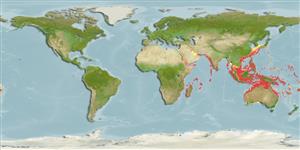Environment: milieu / climate zone / depth range / distribution range
Οικολογία
Θαλασσινό(ά) βενθικό(ς); εύρος βάθους 18 - 141 m (Ref. 4900). Tropical
Indo-West Pacific: Persian Gulf and Red Sea, through the northern Indian Ocean to the South China Sea, north to southern Japan and south to the Indo-Australian Archipelago and New Caledonia. Report from Madagascar needs confirmation.
Μέγεθος / Βάρος / Age
Maturity: Lm ? range ? - ? cm
Max length : 13.0 cm TL αρσενικό/απροσδιόριστο; (Ref. 9824)
Μαλακές ραχιαίες ακτίνες (συνολικά) : 83 - 98; Μαλακές εδρικές ακτίνες: 65 - 77; Σπόνδυλοι: 41 - 42. Body with a large dark spot posteriorly on the base of both the dorsal and anal fins and with elongated anterior rays in the dorsal fin.
Inhabits sand, mud, and gravel bottoms (Ref. 9824). Feeds on benthic animals (Ref. 8924).
Life cycle and mating behavior
Γεννητική Ωρίμανση | Αναπαραγωγή | Γεννοβολία | Αβγά | Γονιμότητα | Προνύμφες
Amaoka, K., O. Okamura and T. Yoshino, 1992. First records of two bothid flounders, Grammatobothus polyophthalmus and Arnoglossus tapeinosoma, from Japan. Jap. J. Ichthyol. 39(3):259-264. (Ref. 9203)
IUCN Red List Status (Ref. 130435: Version 2024-1)
Threat to humans
Harmless
Human uses
αλιεία: περιορισμένης εμπορικότητας
Εργαλεία
Special reports
Download XML
Διαδικτυακές πηγές
Estimates based on models
Preferred temperature (Ref.
123201): 23.3 - 28.3, mean 27.1 °C (based on 792 cells).
Phylogenetic diversity index (Ref.
82804): PD
50 = 0.5000 [Uniqueness, from 0.5 = low to 2.0 = high].
Bayesian length-weight: a=0.00912 (0.00408 - 0.02036), b=3.04 (2.85 - 3.23), in cm total length, based on LWR estimates for this (Sub)family-body shape (Ref.
93245).
Τροφικό Επίπεδο (Ref.
69278): 3.5 ±0.37 se; based on food items.
Ελαστικότητα (Ref.
120179): Μεσαίο(α), ελάχιστος χρόνος για διπλασιασμό πληθυσμού 1,4 - 4,4 έτη (Preliminary K or Fecundity.).
Fishing Vulnerability (Ref.
59153): Low vulnerability (10 of 100).
